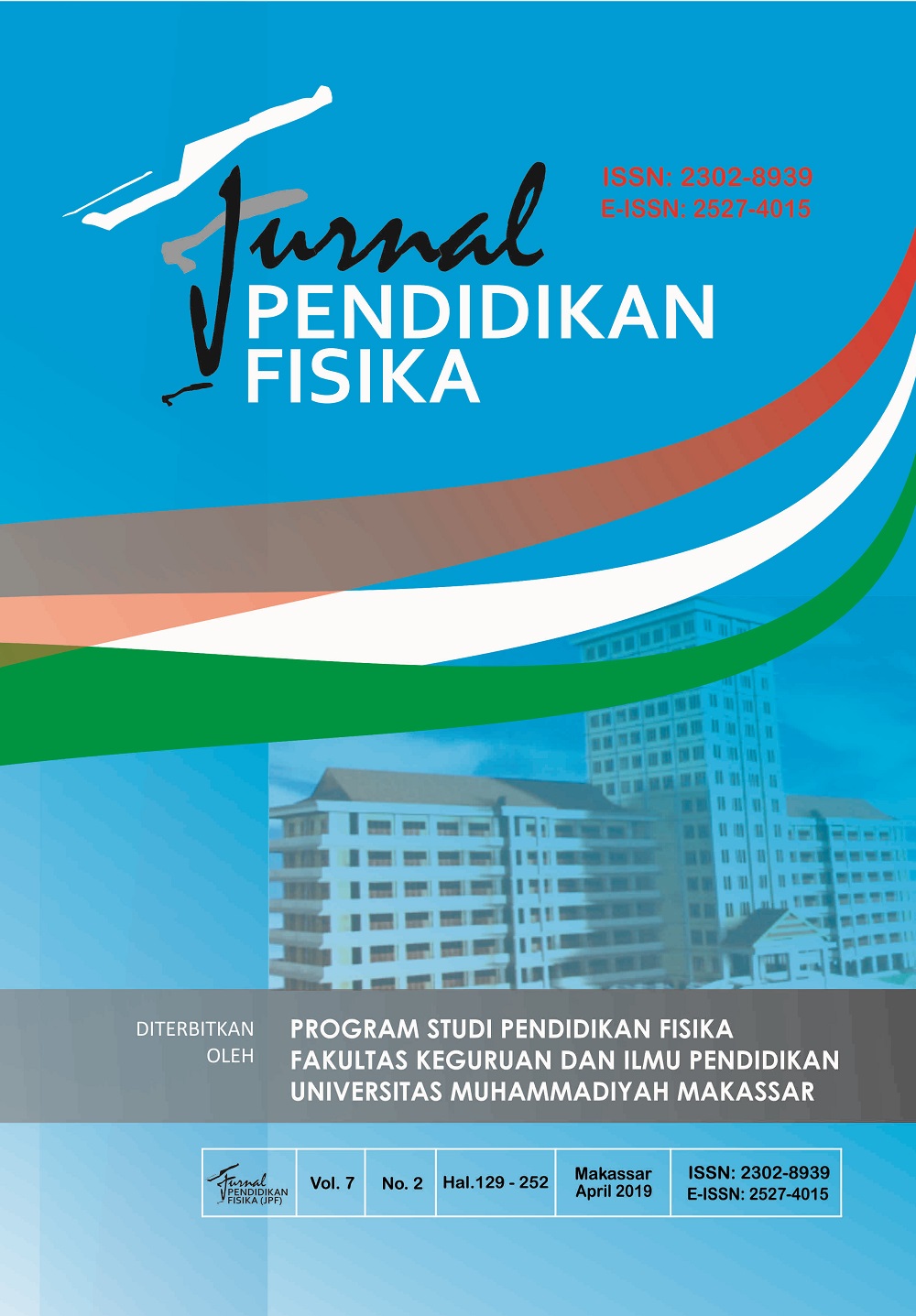The Relationship between Numeric Ability and Students' Critical Thinking Skills in Physics Subjects
DOI:
https://doi.org/10.26618/jpf.v7i2.2082Abstract
This research was an ex-post facto with correlational analysis that aimed to analyze and testing the level of numerical ability and critical thinking skill was achieved by the students of X class at SMA Negeri 8 in Gowa and the relationship between the two variables. Population this research were all students of X class at SMA Negeri 8 in Gowa, the sampling technique was random sampling obtained 92 respondens. The data was analyzed by descriptive statistical analysis and inferential statistical analysis included normality test, linearity test and the correlation of product moment test. Based on this research, it can be concluded that the level of numerical ability of students were in medium category, the level of critical thinking skill was in low category and there was positive and significant correlation between numerical ability and critical thinking skill of students of classes X class SMA Negeri 8 in Gowa.
Keywords: numerical ability, critical thinking skills
Penelitian ini merupakan penelitian ex-post facto yang bersifat analisis korelasional yang bertujuan untuk menganalisis dan menguji tingkat kemampuan numerik dan Keterampilan Berpikir Kritis yang dicapai peserta didik kelas X SMA Negeri 8 Gowa, serta hubungan antara kedua variabel tersebut. Populasi dalam penelitian ini adalah seluruh peserta didik kelas X SMA Negeri 8 Gowa, sampel penelitian diambil secara acak dengan teknik random sampling sebanyak 92 responden. Teknik analisis data yang digunakan adalah analisis statistik deskiptif dan analisis statistik inferensial yang meliputi uji normalitas, uji linearitas dan uji korelasi product moment. Dari hasil penelitian dapat disimpulkan bahwa tingkat kemampuan numerik peserta didik berada dalam kategori sedang, tingkat keterampilan berpikir kritis berada dalam kategori rendah, dan terdapat hubungan positif yang signifikan antara kemampuan numerik dengan keterampilan berpikir kritis peserta didik pada mata pelajaran fisika kelas X SMA Negeri 8 Gowa.
Kata kunci: kemampuan numerik, keterampilan berpikir kritis
References
Ahriana, A. Yani, and Ma’ruf, “Jurnal Pendidikan Fisika Universitas Muhammadiyah Makassar Studi Analisis Hubungan Antara Self Efficacy dengan Hasil,” J. Pendidik. Fis., vol. 4, no. 2, pp. 223–238, 2016.
S. Afriza, A. Hamid, and Marwan, “Pengaruh Kemampuan Numerik terhadap Hasil Belajar Fisika Siswa Kelas XI SMA Negeri 5 Banda Aceh,” J. Ilm. Mhs. Pendidik. Fis., vol. 1, no. 4, pp. 161–163, 2016.
Syamsidar, U. M. M. Maruf, Maruf, and R. Hustim, “Jurnal Pendidikan Fisika Universitas Muhammadiyah Makassar Pembelajaran Fisika Berbasis Cone of Experience Edgar Dale,” vol. 6, pp. 1–12, 2018.
A. N. Nurdin, “Analisis Hubungan Kemampuan Numerik dengan Hasil Belajar Fisika Peserta Didik Kelas XII IPA SMA Muhammadiyah Makassar,” J. Pendidik. Fis. Univ. Muhammadiyah Makassar, vol. 5, no. 2, pp. 193–204, 2017.
H. H. Uno and M. Kuadrat, Mengelola Kecerdasan Dalam Pembelajaran Sebuah Konsep Pembelajaran Berbasis Kecerdasan. Jakarta: Bumi Aksara, 2010.
D. Isworo, W. Sunarno, and D. Wahyuningsih, “Hubungan Anatar Kreativitas Siswa dan Kemampuan Numerik dengan Kemampuan Kognitif Fisika Siswa SMP Kelas VIII,” J. Pendidik. Fis., vol. 2, no. 2, p. 35, 2014.
A. Suprijono, Model-Model Pembelajaran Emansipatoris. Yogyakarta: Pustaka Belajar, 2016.
M. Surya, Strategi Kognitif dalam Proses Pembelajaran. Bandung: Alfabeta, 2015.
M. Tawil and Liliasari, Berpikir Kompleks dan Implementasinya dalam Pembelajaran Ipa. Makassar: Badan Penerbit Universitas Negeri Makassar, 2013.
Downloads
Published
Issue
Section
License
Copyright:
Authors who publish with this journal agree to the following terms:
1. Authors retain copyright and grant the journal right of first publication with the work simultaneously licensed under a Creative Commons Attribution-ShareAlike 4.0 International License that allows others to share the work with an acknowledgement of the work's authorship and initial publication in this journal.
2. Authors are able to enter into separate, additional contractual arrangements for the non-exclusive distribution of the journal's published version of the work (e.g., post it to an institutional repository or publish it in a book), with an acknowledgement of its initial publication in this journal.
3. Authors are permitted and encouraged to post their work online (e.g., in institutional repositories or on their website) prior to and during the submission process, as it can lead to productive exchanges, as well as earlier and greater citation of published work.
Licence:
Authors are free to:
1. Share: Copy and redistribute the material in any medium or format
2. Adapt: Remix, transform, and build upon the material for any purpose, even commercially.
The licensor cannot revoke these freedoms as long as the authors follow the license terms, which include the following:
1. Attribution: You must give appropriate credit, provide a link to the license, and indicate if changes were made. You may do so in any reasonable manner, but not in any way that suggests the licensor endorses you or your use.
2. ShareAlike: If you remix, transform, or build upon the material, you must distribute your contributions under the same license as the original.
3. No additional restrictions: You may not apply legal terms or technological measures that legally restrict others from doing anything the license permits.
Jurnal Pendidikan Fisika is licensed under a Creative Commons Attribution-ShareAlike 4.0 International License.

